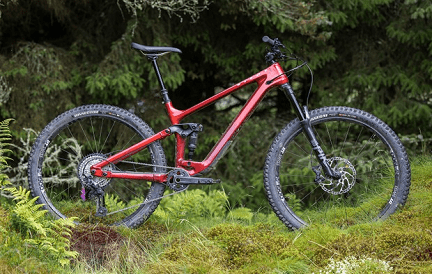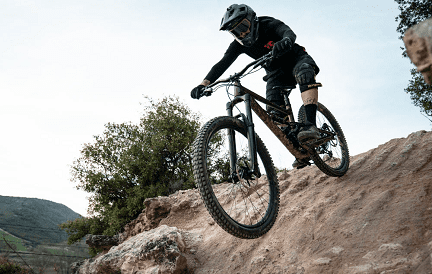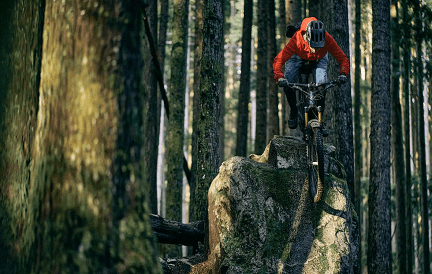We will talk about everything you need to know about downhill bikes, choosing the best downhill mountain bike based on frame size, materials made with, the best downhill bikes right now, as well as the recommended components for Dh bikes.
- Part 1: What Are Downhill Bikes
- Part 2: What Size Dh Bike Do You Need
- Part 3: Buyer’s Guide for Dh Bikes
- Part 4: The Best Downhill Bikes Now
- Part 5: FAQs
Part 1: What Are Downhill Bikes
Downhill bikes are the bikes used for the downhill mountain biking discipline. They are bikes specifically for going down slopes at high speeds. Downhill bikes are full suspension mountain bikes (both front and rear suspensions), built to withstand steep, technical terrains. They are for impact and rough riding. The best downhill mountain bikes use for easy maneuverability and stability.
Downhill bikes have an average suspension of 170mm and an average wheel size. They are equipped with long-travel suspensions, large disk brakes, flat tires, and stronger rims that do not deform on impact.
Downhill bikes are strong and durable, slightly heavier than the traditional mountain bikes, and offer better stability and comfort when riding on slopes. They are not so great for climbing, as they are much heavier than the traditional mountain bike, it would take effort to climb with a downhill bike.
Most downhill bike frames are made from hard materials like carbon fiber, steel alloy, and aluminum which keeps the bikes stable and strong.
Features of Downhill Bikes
Here are the features of downhill bikes.
Forks
Downhill bikes have dual crown forks with 8 inches of travel. They are designed for impact and offer compression adjustment for riders to tune their forks according to the terrain.
Suspension Travel
Suspension travel is the amount of movement the suspension mechanism allows. It is a measure of how much the wheel axle moves when the suspension compresses.
Most downhill bikes have suspension travel up to 170mm – 200mm. The front suspension travel usually matches the rear travel, but in some cases, it is more.
Suspension Type
There are two main types of suspension in Downhill mountain bikes.
Coil Suspension
Coil suspensions are the most commonly used for Downhill bikes. The best Dh bikes use coil springs. They are metal corkscrew coil that does not operate with springs, which give them less friction, provide a sensitive trail feeling, and absorb heat better. Coil springs are heavier than air springs. They react faster to impacts and give a smoother ride feeling.
Air Suspension
Air springs are more expensive, lightweight, and provide more tuning ability. Though, they do not provide the sensitivity and performance of coil springs. Air suspensions require a tight seal to capture air under high pressure. It does not give a sensitivity trail feeling.
Geometry
Downhill bikes come with a slack geometry which means the angle of the steep head and seat tube are lower mid 60 degrees. And this places the rider farther back on the bike and the front wheel front. Also, the geometry of downhill bikes can handle steep trails without pitching the rider forward.
Brakes
Like most mountain bikes, downhill mountain bikes use hydraulic disk brakes with 4 pistons. They are reliable brakes with maximum stopping power.
Wheels
Unlike the traditional mountain bikes, downhill bikes still feature the 26 wheels, as they have stronger rims, and are easier to maneuver. And they also offer 27.5/650B.
Full Suspension
Downhill bikes offer full suspensions to absorb the impact of the terrain. The full suspension features both front and rear shocks. On some downhill mountain bikes, the rear shock is a mix of both coil suspension and air suspension.
Gears
Most downhill bikes have a single chainring in the front, between 32T – 36Tin size, a limited cassette on the rear side, and usually have between 7 to 10 gears. The gear suitable for downhill riding is the high gear.
Downhill mountain bikes are usually equipped with a 1×7 speed drivetrain. They are designed for achieving maximum speed while descending.
Frame Material
Like traditional mountain bikes, Dh bikes feature aluminum frames, carbon fiber frames, and steel alloy frames.
Aluminum – Aluminum frames are the most commonly used and affordable frame material. They are light and stiff. But, aluminum bike frames are harsher to ride.
Carbon Fiber – carbon fiber is a thin material, made of very thin strands of carbon, twisted and woven together like cloth. It is lighter than aluminum. Carbon fiber frames are better at absorbing vibrations than aluminum frames, and they are more expensive.
Steel Alloy- steel alloy frames are strong, responsive, and durable. They are more expensive than aluminum frames and much heavier than aluminum and carbon fiber frames.
Bike Weight
Downhill bikes are heavier due to full suspension and the frame material.
Handlebar Width
The handlebar width for most downhill bikes is between 760-880 mm.
Tires
Downhill bikes spot a tubeless tire set up, with large spacing between tire knobs.
Part 2: What Size Dh Bike Do You Need
You may not have the perfect size downhill bike unless you purchase a bespoke custom-made frame. The manufacturers of downhill cycles make a few different size frames to fit riders of different shapes and sizes. To find an exact bike fit, you have to be the perfect size for the frame which is unlikely.
Here’s a bike size chart for Dh bikes.
Rider’s height in ft
Bike Size Frame size
5ft 4in- 5ft 7inch small 14 -16inches
5ft 7in- 5ft 10inch Medium 16 – 18inches
5ft 10- 6ft 1inch Large 18 – 20inches
6ft 1in and above Extra large 20 -22 inches
As a Dh beginner, sizing down your bike will give you more control.

Part 3: Buyer’s Guide for Dh Bikes
Here is what to look out for when buying a Dh bike. Remember downhill bikes are not good for climbing, they are only good for going downslope. Downhill bikes cannot be used as your traditional mountain bike.
Bike Frames
Downhill bike frames are designed for the thoroughness of Dh riding. Dh bike frames are made from different materials.
They have large rear hubs, and double crown forks, and usually have at least 8mm worth of travel. The suspension, geometry, and weight affect how well the bike will handle.
Types of Frame Design
Downhill bike frames are categorized according to the type of suspension they use. Each suspension has its uniqueness. There are basically three types of rear suspension.
Single pivot, multi-link design, and four bar linkage.
Single pivot- in single pivot suspension, the rear wheel is allowed to pivot around a single point on the frame. Single pivots require less maintenance and are easy to service. Although a major disadvantage is that the force from braking, usually interferes with the suspension.
Multi-link- the multi-link rear suspension, also a virtual pivot, uses two links to connect a rigid rear triangle to the frames and shocks allowing for a variable axle path and isolation of pedaling forces.
Four bar linkage- four bar linkage has shocks bolted to the frame at an end, and a pivot in the chainstay.
Every rider has their preference, but each design feels different, and they all perform exceptionally well.
How a bike feels is dependent on what materials of the frames. Most downhill bike frames use carbon fiber, aluminum, alloy, and a combination of materials. While, downhill best bike frames use carbon fiber and are more expensive.
In picking the best downhill cycle frame for you, you need to consider your riding style. Although most bikes can set up for any riding style due to the tuning ability of modern suspensions.
Wheel Size
Downhill bikes use the same wheel size as the traditional Mtb. If you’re confuse about your bike size, please refer to our bike size chart. As with most mountain bikes, 26-inch wheels are obsolete and have been replaced by 27.5 in/650B or 29 inches wheels.
Comparison between Dh bike wheel sizes: which is better.
27.5/650 vs 29 inch
The wheel size best for you depends on your body physique. A taller rider would need a bigger bike and vice versa.
When it comes to speed, if you are planning to race, we would recommend the 29-inch bike for you as they are better at maintaining speeds.
However, when it comes to drop offs and jumps, the 27.5 in is recommended because it is easier to maneuver than the 29-inch bike.
Crank
Another thing to consider when buying a downhill bike is the crank length. It is advisable to buy bikes with light cranks that give the best pedaling efficiency. Due to needing better ground clearance when pedaling, downhill cranks are not larger than 165mm
Crank type- if you are on a budget, an alloy crank would be best. If you’re trying to save weight, it would be best to go for carbon cranks. They are lighter than alloy and give a damped feel when riding. Although carbon cranks are significantly more expensive than alloy cranks.
Price/ Budget
Your budget determines the kind of downhill bike you can purchase, whether high-end or low-end bikes.
The price of downhill bikes ranged from $2400 – $12000. So, the more you spend on your bike, the better and more upgraded the bike components are.
Expensive Dh bikes have high-end components, then, you can tune the suspensions to suit your riding style and track type.
Cheap Dh bikes are low-end and can fit with heavy components. Also, their suspension adjustability is limited.
Part 4: The Best Downhill Bike Right Now
The best downhill bike right now is the canyon sender CF bike. It has a full carbon fiber frame, tubeless tires, SRAM GX DH 7-speed drivetrain, and BoXXer RC fork with Charger damper.
Also, it has a slightly longer wheelbase of 1273mm. Besides, it is a large bike, fast, easy to maneuver, and stable.
The canyon sender CF bike 7.0, has a four-bar Horst link rear-end that delivers 200mm of travel. The chainstay length of the bike is adjustable, between 446mm, and uses flip chips at the rear dropouts.
The price of this bike is about $4800. Also, it is very fast and gives a smooth ride feeling.
Part 5: FAQs
1. Is buying a full downhill bike worth it?
If you aren’t planning on riding downhill, then there is no need to purchase a downhill bike and if you need a downhill bike you can use for traditional mountain biking, then we would advise you to go for enduro bikes. They are the best bikes downhill if you cannot handle a full downhill bike. But If you plan on racing, and have access to a chair lift, you can purchase a full downhill bike.
2. How long do downhill bikes last?
When you maintain your downhill bike, it can last up to 20 years. Also, depending on the material the frames, carbon fiber bikes can last longer than steel alloy Dh bikes.
3. Can I get a second-hand downhill bike?
If you are on a budget, getting a second hand downhill bike may not be a bad option, as long as you ensure the bike is in good condition.
4. Where can I get a good downhill mountain bike?
You can either order online or purchase from your local bike shop. Make sure to size the bike before purchase.
5. What is the best mountain bike for downhill?
As said, downhill bikes are not the traditional mountain bike and are difficult to ride uphill. The best downhill cycle for you could be an enduro bike since they are also great at downhill rides.
Choosing the best Dh bike for you can be based on riding style and personal preference which depends on frame materials, crank, budget, and the bike frame.









